Section 1.3 Adding Vector and Solving Vector Equations
Subsection 1.3.1 Adding Vectors
Subsubsection 1.3.1.1 Adding Vectors Component-by-Component
You can add vectors diagramatically or analytically. I will show first how to do it analytically using the coordinate-form of the vectors. Suppose you have two position vectors \(\vec r_1 \) and \(\vec r_2 \) and you want their sum \(\vec r_{\text{sum}} \text{.}\) Formally, we write this as a vector equation
This is just a formal definition. THIS DOES NOT MEAN LENGTH OF THE SUM VECTOR IS EQUAL TO THE SUM OF THE LENGTHS OF THE TWO VECTORS BEING SUMMED!!!. Writing this definition of sum by coordinate representations of the three vectors, we might write it like the following.
You will learn below that you can sum two vectors by placing one vector at the tip of the other vector and the sum will be from the tail of the first to the tip of the second. If you look at the diagram, you will immediately see that \(x_\text{sum}\) is just sum of \(x_1\) and \(x_2\text{,}\) and similarly for the \(y\) parts.
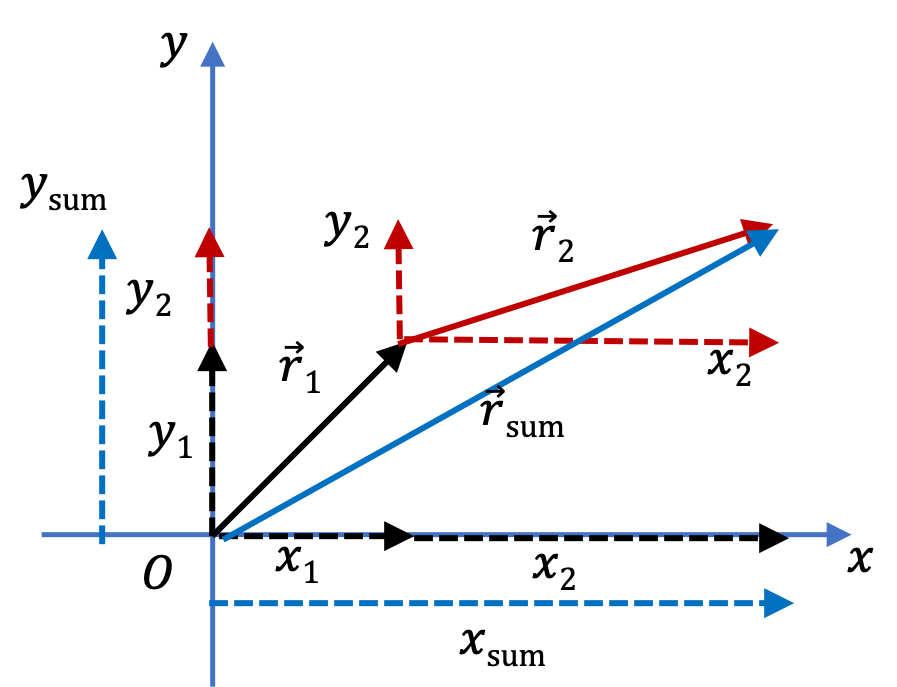
Now, if we wanted the magnitude and direction of the sum vector, we can just use the \((x,y) \) to \((r, \theta)\) transformations, as we do for any vector.
Once we get the angle, we deduce the direction from the angle value based on the quadrant the vector is pointed, and then we state the direction as clockwise or counterclockwise angles from Cartesian axes.
Often a table of components helps organize the calculations. This is illustrated in Example 1.3.5.
Checkpoint 1.3.2. Adding Two Forces Given in Component Form.
Suppose a box is being pushed by two forces, which are given to us in component form, as \((F_x, F_y)\text{:}\)
What are the magnitude and direction of their sum, also called the net force, \(\vec F_{\text{net}}\text{.}\)
Add components first.
\(50\text{ N},\, 53.1^{\circ} \) counterclockwise from positive \(x \) axis.
From the discusssion of this section, we know that the components of the sum can be easily obtained from the components of the summand.
Therefore, the magnitude of the sum is
To get the direction, we find the angle first by
Since point \((30, 40)\) is in the first quadrant, the direction of the net force is counterclockwise from the positive \(x \) axis.
Checkpoint 1.3.3. Adding Two Forces Given in Magnitude-Direction Form.
Suppose a box is being pushed by two forces, which are given to us in magnitude-direction form in the \(xy\) plane:
Use coordinate axes with positive \(x \) towards East and positive \(y \) towards North. What are the magnitude and direction of their sum? Note: magnitude is not equal to \(70\text{ N}\text{.}\)
First write the given forces in the component forms.
\(50\text{ N},\, 53.1^{\circ} \) clockwise from positive \(x \) axis.
We will need to first write the given forces in their component forms. Let \(x \) axis be towards East and the \(y \) axis towards North. Then, here the component forms of the two given forces are easy to work out.
Let's write \(\vec F \) for the sum vector. The components of the sum are then
Therefore, the magnitude of the sum is
To get the direction, we find the angle first by
Since point \((30, -40)\) is in the fourth quadrant, the direction of the net force is clockwise from the positive \(x \) axis.
Checkpoint 1.3.4. Adding Two Force Vectors.
Consider two force vectors, \(\vec F_1 \) that has a magnitude \(25.0\text{ N}\) in the direction of East, and \(\vec F_2 \) that has a magnitude \(40.0\text{ N}\) in the direction of \(30^{\circ}\) North of East. What are the magnitude and direction of their sum, \(\vec F_1 + \vec F_2\text{?}\) For stating directions in space, let \(x \) axis be pointed towards East, \(y \) axis be pointed towards North, and \(z \) axis be pointed Up.
Add \(x \) components separately from the \(y \) components.
\(62.9\text{ N}, 18.6^{\circ} \) counterclockwise from East towards North.
First we find the component forms of each vector, and then will sum components in each direction separately.
Now, adding values along each axis separartely, we get \(x \) and \(y \) components of the sum. Let us denote them by \(F_x \) and \(F_y\text{.}\)
From these components, we can get the magnitude and direction. Since the values of \(F_x \) and \(F_y\) places the vector in the first quadrant, the angle will just be the counterclockwise from the positive \(x \) axis.
Example 1.3.5. Adding Forces Using an Organizing Table.
Suppose we want to add three forces shown in Figure 1.3.6.
(1) \(15.0\text{ N} \) force pointed down, (2) \(12\text{ N} \) force pointed \(54^{\circ}\) below horizon, and (3) \(10.0 \text{ N} \) force pointed up.
(a) Organize the components of these forces in a table and find the components of the sum.
(b) Find the magnitude and direction of the sum.
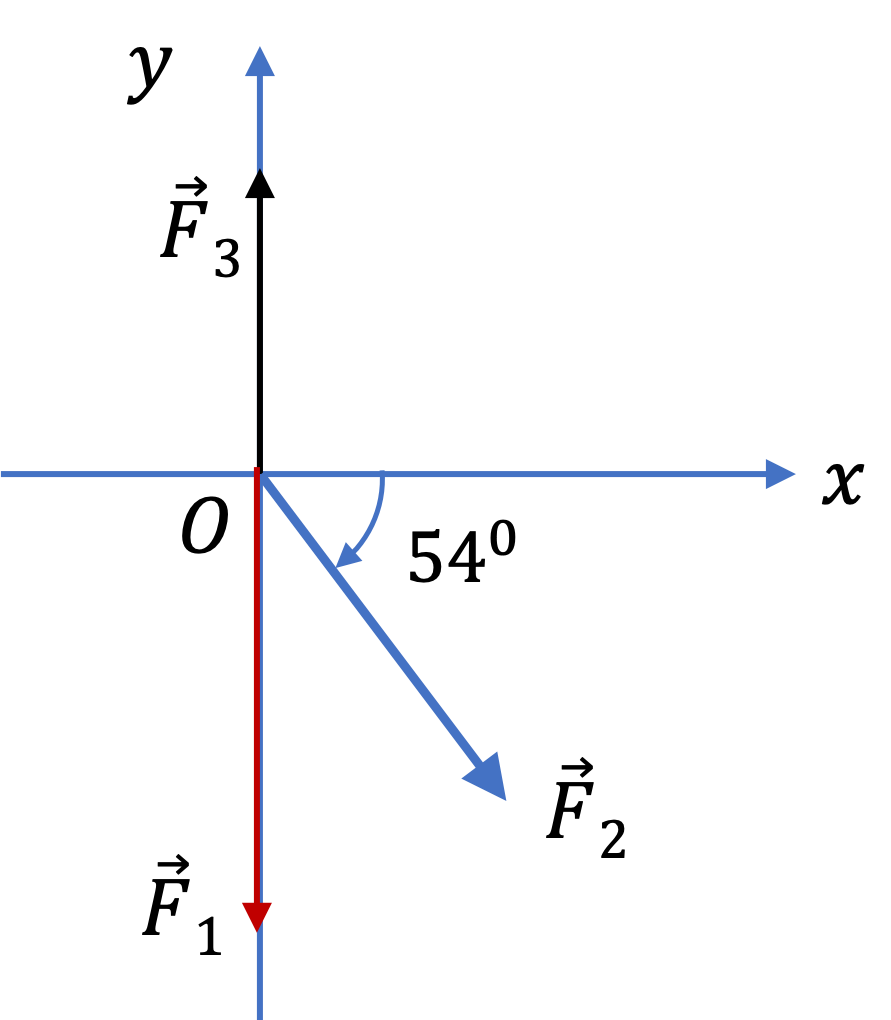
Find the components and make a table with three columns - name, \(x \) component, \(y\) component.
(a) \(( 7.05\text{ N}, -14.7\text{ N})\text{,}\)
(b) \(16.30\text{ N}, \) \(64.4^{\circ}\) clockwise from the positive \(x \) axis in the fourth quadrant.
We can make the following table to help us organize the components
| Force | \(x\)-component | \(y\)-component |
| \(F_1 \) | \(0\) | \(-15.0\text{ N}\) |
| \(F_2 \) | \(12\text{ N}\, \cos\, 54^{\circ}=7.05\text{ N}\) | \(-12\text{ N}\, \sin\, 54^{\circ}=-9.71\text{ N}\) |
| \(F_3\) | 0 | \(10\text{ N}\) |
From this table we find the components of the sum.
We use the components and find the magnitude to be
and the angle with respect the the \(x \) axis
which means \(64.4^{\circ}\) clockwise from \(+x\) axis in the fourth quadrant.
Checkpoint 1.3.8. Adding Three Velocity Vectors.
Consider the following three velocity vectors:
What are the magnitude and direction of their sum, \(\vec v_1 + \vec v_2 + \vec v_3\text{?}\) For stating directions in space, let \(x \) axis be pointed towards East, \(y \) axis be pointed towards North, and \(z \) axis be pointed Up.
Be careful with the signs. The \(v_{3x} \) should be negative.
\(34.64\text{ m/s}, 69.7^{\circ} \)
We start by working out the components of each of the three velocity vectors. The components of \(\vec v_1 \) and \(\vec v_2 \) do not give us any trouble.
However, we need to be careful when we work on \(\vec v_3 \) since the vector is pointed in the second quadrant of the \(xy \) plane. When we peoject the arrow of the vector \(\vec v_3 \) on the \(x \) axis, we strike the negative \(x \) axis, which means that \(v_{3x} \lt 0 \text{,}\) i.e., negative.
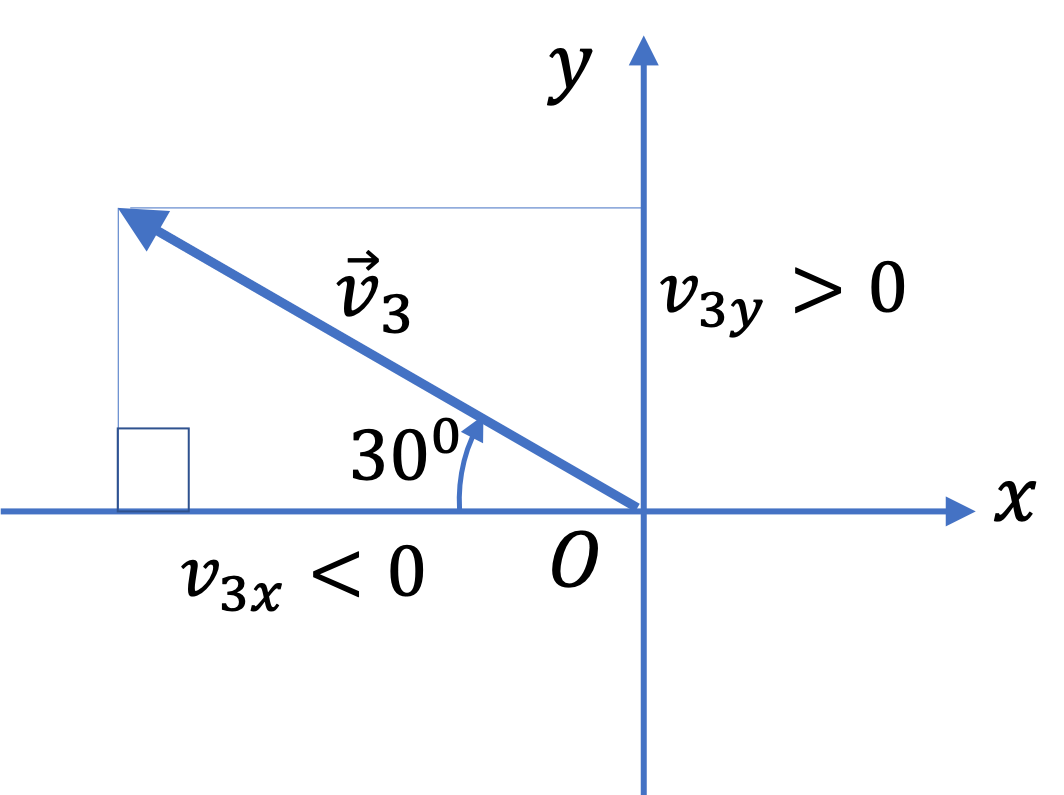
The components of the sum, to be written as \(v_x \) and \(v_y\) will be
This results in the following magnitude and angle
Subsubsection 1.3.1.2 Adding Vectors Diagramatically
In diagram form, the sum \(\vec r_{\text{sum}}\) is the diagonal vector in the parallelogram constructed from \(\vec r_1\) and \(\vec r_2\) when \(\vec r_1\) and \(\vec r_2\) are drawn from the same point as shown in Figure 1.3.10(a). This is called the parallelogram law of addition.
An alternative view of vector addition by a diagram is shown in Figure 1.3.10(b). Here, we move the second vector so that it starts at the tip of the first vector. Then, the vector from the tail of the first vector to the tip of the second vector would be the same as the diagonal of the corresponding parallogram, and hence would be the sum of the two vectors. This method is often called tip-to-tail method of addition.
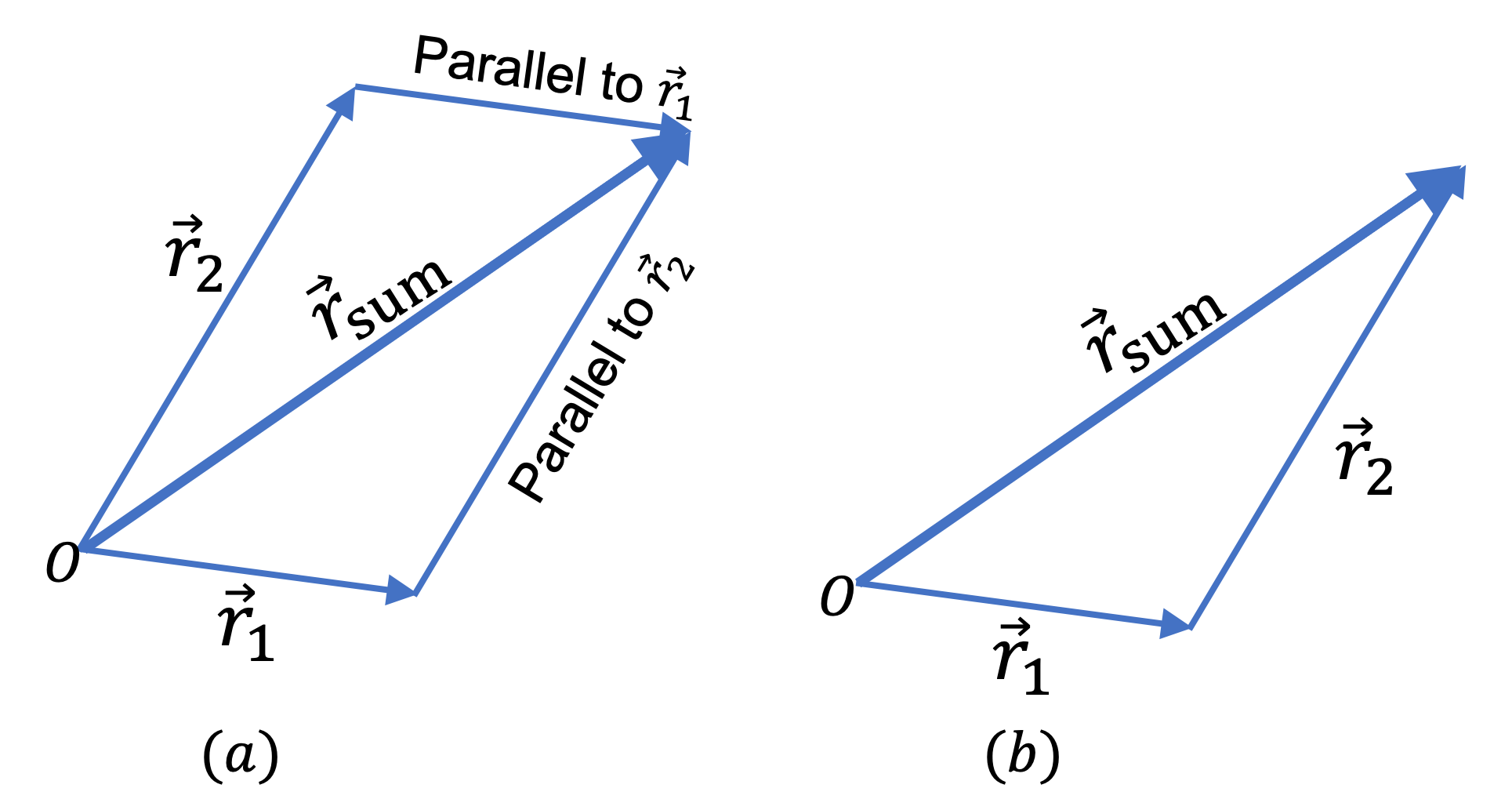
Checkpoint 1.3.11. Adding Vectors Graphically.
(a) From Figure 1.3.12 , read off magnitudes and directions of vectors \(\vec A \) and \(\vec B \text{,}\) draw the negative of vector \(\vec B \text{.}\) Lets call it \(\vec C\text{.}\)
(b) Find the magnitude and direction of \(\vec A - \vec B\) in two ways: (i) from the components of \(\vec A + \vec C\text{,}\) and (ii) graphically from the parallelogram formed by \(\vec A \) and \(\vec C \text{.}\)
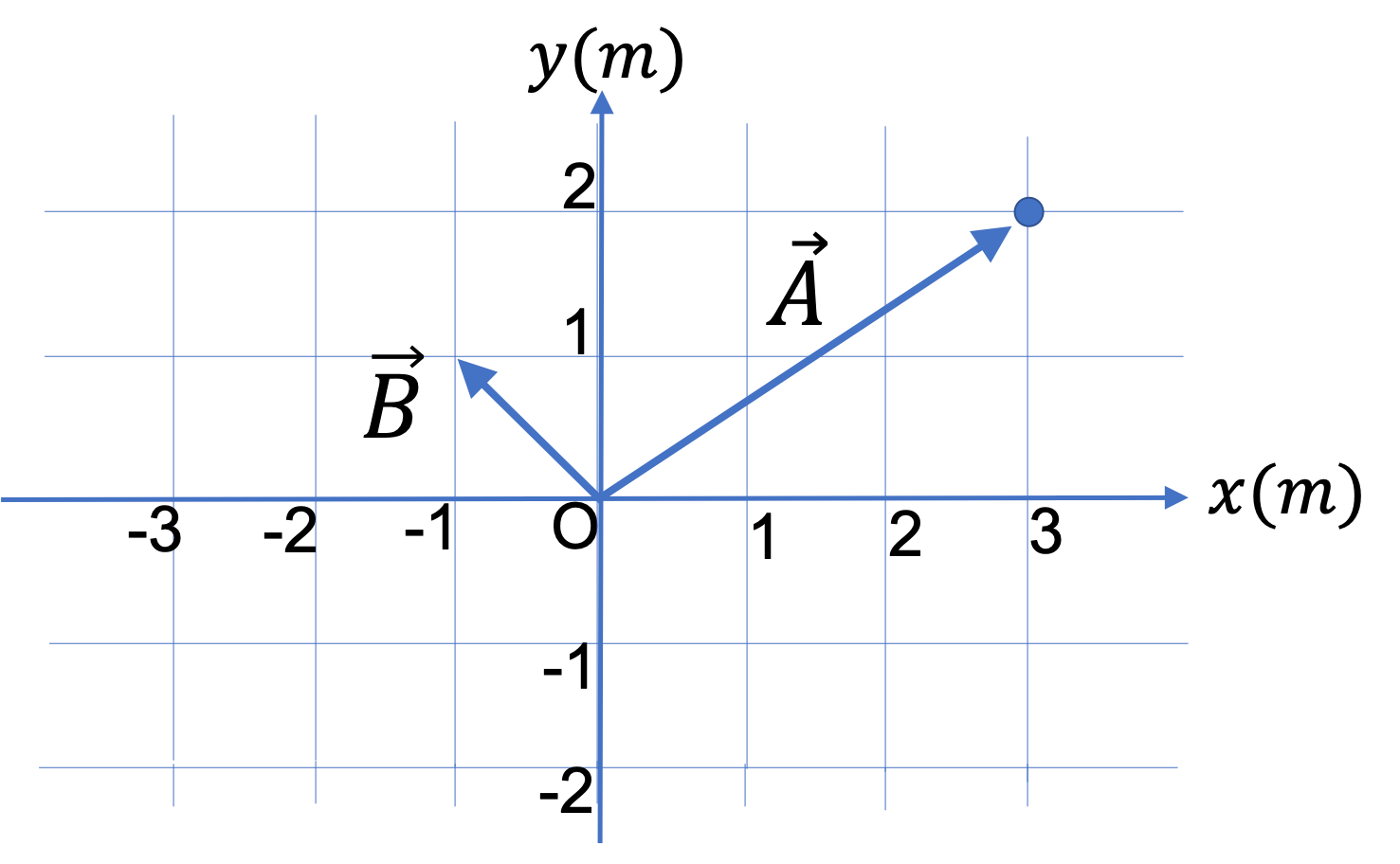
For (b) (i), read off the components of \(\vec A \) and \(\vec B \) and then work out the algebra. For (b) (ii), us a ruler to read off the length of the vector and a protractor to read the angle.
(b) (i) \(\sqrt{17}\text{ m}, 14.0^{\circ} \) counterclockwise from \(+x\) axis.
(a) We first draw vector \(\vec C\) as shown in Figure 1.3.13.
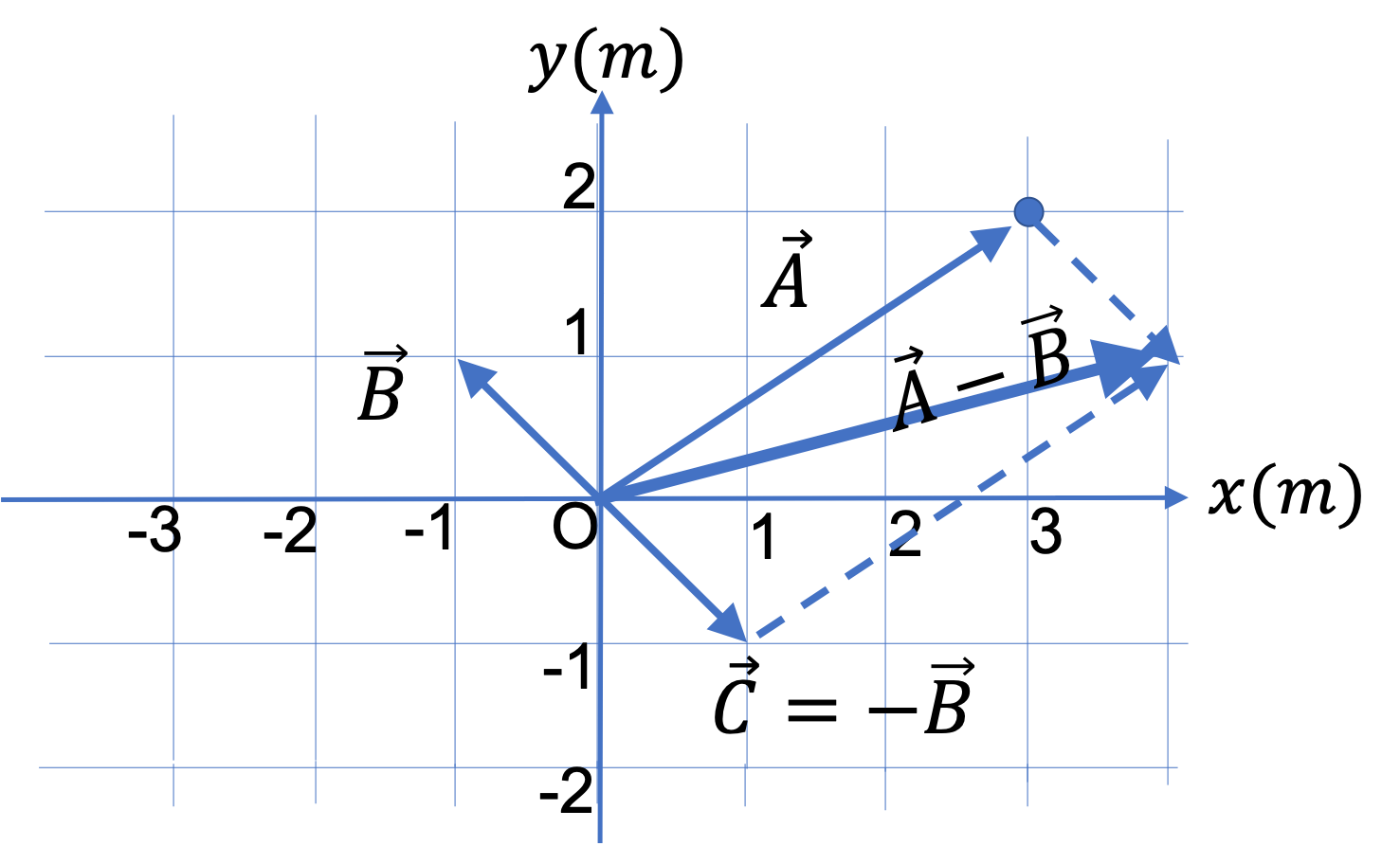
(b) (i) We add \(\vec A \) and \(\vec C\) using their components. Let's denote the sum by \(\vec D\text{.}\)
Therefore, the magnitude and angle are:
Since \((4,1) \) is in the first quadrant, the direction is this angle counterclockwise from the positive \(x \) axis.
(b) (ii) I printed out the figure and used a ruler and a protractor to get the length and the angle - this will give only approximate values, and that's okay. Read directly, the magnitude is \(\approx 4.0 \) and the counterc;ockwise angle from the positive \(x \) axis is \(\approx 15^{\circ}\text{.}\) These values are close enough to the exact values in (i).
Subsection 1.3.2 Solving Vector Equations
The sum equation, Eq. (1.3.1), viz., \(\vec r_\text{sum} = \vec r_1 + \vec r_2\text{,}\) is an example of a vector equation, where the left and right sides of the equation are vector quantites written in abstract formal symbols. In the coordinate forms of the vectors, we saw that \(x \) components come together separately from the \(y \) components and resulted in simple algebraic equations for \(x\) and \(y\) components.
Simplest vector equation will have two vectors that are equal to each other. For example
What this is saying is that the two vectors have the same magnitude and the same direction.
If we look at the components of \(\vec A \) and \(\vec B \text{,}\) we will conclude that, they have the same components.
A more general example of a vector equation will be
This will give us the following three equations for the components.
Checkpoint 1.3.14. Negative of a Vector.
Two vectors \(\vec A \) and \(\vec B \) add up to give a zero vector. Suppose vector \(\vec A \) is known, what can you say about the magnitude and direction of vector \(\vec B\text{?}\)
Think what happens when you change the sign of a vector
\(B = A\text{,}\) opposite direction of \(\vec A\text{.}\)
We are given that
Solving for \(\vec B \text{,}\) we get
That is, \(\vec B \) is just \(\vec A \) woith direction flipped. Therefore, \(\vec B \) has the same magnitude as \(\vec A \) but has opposite direction
Checkpoint 1.3.15. Finding the Third Force that will Balance Two Other Forces Given in Component Form.
Consider a situation in which three forces cancel out. Two of the forces are given in the component form in the \(xy\)-plane as \(\vec F_1 = (20 \text{ N}, 10 \text{ N}) \text{,}\) and \(\vec F_2 = (-30 \text{ N}, 10 \text{ N}) \text{.}\)
(a) What are the magnitude and direction of the third force? (b) Draw the three forces in the tip-to-tail manner and show that they form a closed path.
(a) Thinking in terms of components is helpful. (b) Why would they form a closed path? Think what their sum is.
(a) \((10\text{ N} , -20 \text{ N}) \) in component form, giving magnitude \(10\sqrt{5}\text{ N} \text{,}\) and the angle, \(\theta = 63.4^\circ\) clockwise into the fourth quadrant.
(a) Let us call the third force \(\vec F_3 \text{.}\) Then, we are given that
Therefore,
which means, the components of \(\vec F_3\) will be opposite of those of the sum of the other two force. Hence, (note: as in other places, we omit units in calculations, but put the units back in the final result.)
Therefore the magnitude and angle of \(\vec F_3 \) are
Since \((F_{3x} , F_{3y}) = (10, -20) \) in the fourth quadrant, the direction is \(63.4^{\circ}\) clockwise from positive \(x \) axis.
The three forces placed tip-to-tail should form a closed loop for their vector sum to be zero. We draw \(\vec F_1\) and \(\vec F_2\) to scale, and then find \(\vec F_3\) from the tip of \(\vec F_2\) to the tail of \(\vec F_1\text{.}\)
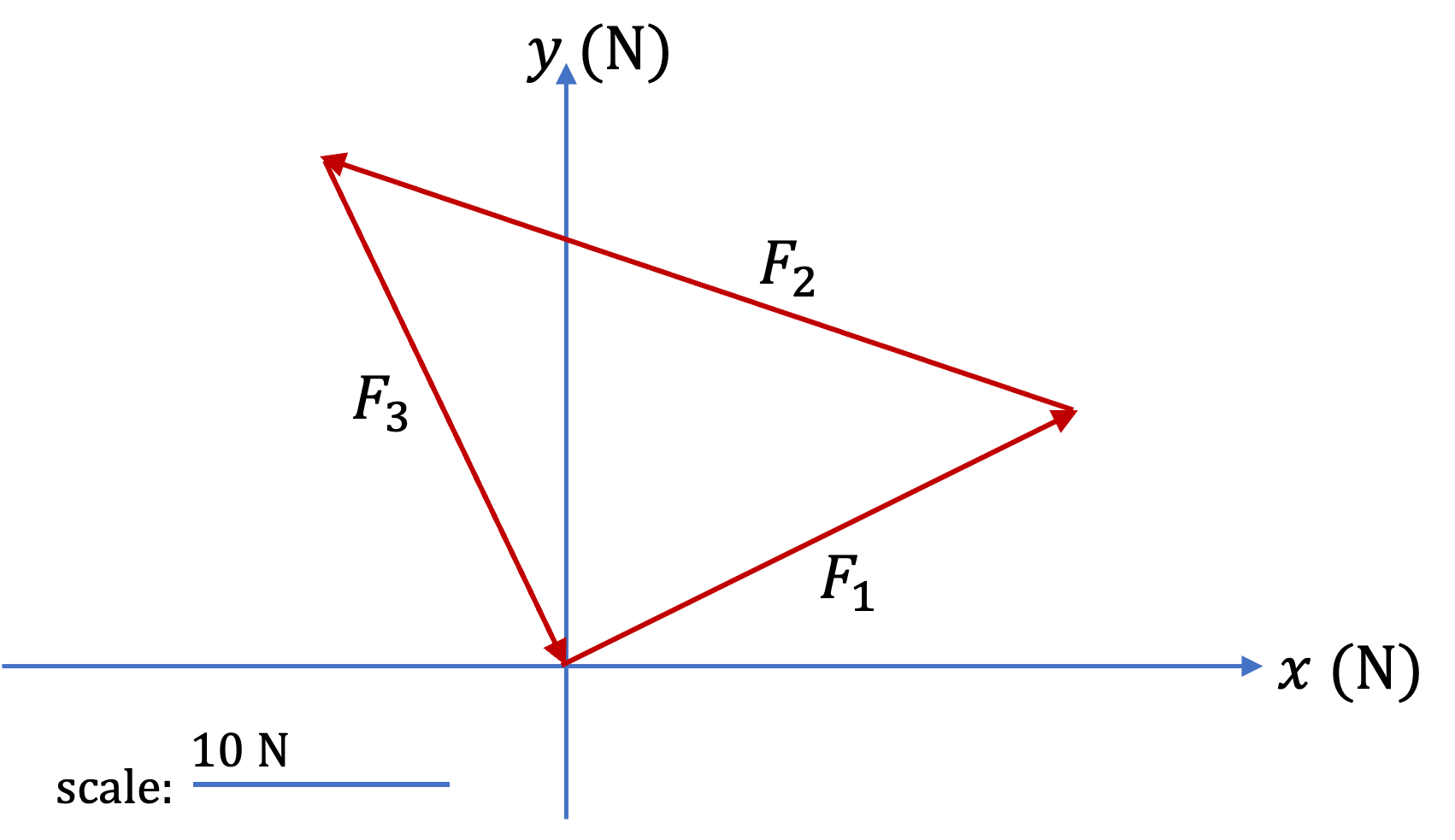
Checkpoint 1.3.17. Finding the Third Force that will Balance Two Other Forces Given in Magnitude-Direction Form.
Consider a situation in which three forces cancel out, i.e., their vector sum is equal to zero. Two of the forces are: \(\vec F_1 = (12\) N, due East), and \(\vec F_2 = (5\) N, due North).
(a) What are the magnitude and direction of the third force?
(b) Draw the three forces in the tip-to-tail manner and show that they form a closed path. Why would they form a closed path? Hint: Think about their sum.
Convert the given forces to component form first.
(a) \((-12\text{ N} , -5 \text{ N}) \) in component form with \(x \) towards East and \(y \) toward North. This will give magnitude = \(13 \text{ N}\text{,}\) and the angle will be in the third quadrant, \(22.6^\circ\) south of west.
(a) Let us call the third force \(\vec F_3 \text{.}\) Then, we are given that
Therefore,
which means, the components of \(\vec F_3\) will be opposite of those of the sum of the other two force. From the magnitudes and directions of \(\vec F_1 \) and \(\vec F_2 \) we find their component forms to be
Therefore, for \(\vec F_3 \) we get
Therefore the magnitude and angle of \(\vec F_3 \) are
Since \((F_{3x} , F_{3y}) = (-12, -5) \) in the third quadrant, the direction is \(22.6^{\circ}\) counterclockwise from the negative \(x \) axis. This is \(22.6^{\circ}\) South of West.
